Abstract
Fracture propagating along the grain of timber is one of the most relevant failure mechanisms due to the wood’s low strength and its brittle failure behaviour when subjected to excessive shear and tensile stresses perpendicular to the grain. According to the current procedures, the fracture energy of wood is determined on small clear specimens. However, for the prediction of the structural behaviour of full-scale structural timber members, the influence of knots has to be accounted for. The discrepancy between the fracture behaviour of small specimens and members of structural size has already been observed in several studies. The aim of this paper is to provide a review on a selection of these studies and to discuss their relevancy for the evaluation of the fracture properties and the structural behaviour of full-scale structural timber.
Introduction
Wood is a natural material, exhibiting various inhomogeneities and growth characteristics. However, basic material properties are often determined on small clear specimens, neglecting these inhomogeneities. It is, therefore, a general recommendation to determine material property values on specimens of structural size in order to be able to reliably predict the structural behaviour and the load-carrying capacity of timber members in practice.
Wood exhibits its highest strength and stiffness when loaded parallel to the fibre (grain) direction. The strength and stiffness reduces drastically in case of deviations from this optimal loading direction. Cracking in tension perpendicular to the grain or shear (e.g. due to grain deviations and weak sections around knots) is responsible for up to 70% of failures of structures (Frühwald Hansson Citation2011). Test standards regulating the determination of characteristic values of material properties require certain minimum dimensions of the specimens tested in order to cover the natural variability to be expected in practical application of the products.
When subjected to tension stresses perpendicular to the grain, wood exhibits very low strength together with brittle failure behaviour. Fracture of timber with crack propagation along grain is one of the most frequent failure mechanisms in timber structures. The determination of material properties describing fracture energy is not specified in current European test standards. Available test procedures for the determination of mode 1 fracture energy (tension perpendicular to grain) and mode 2 fracture energy (shearing) involve testing of small clear specimen. In such tests, the cracks commonly propagate parallel to the grain direction. In the vicinity of knots or in other areas containing grain deviations, the crack path is disturbed which can cause an increase in the resistance against crack growth. Together with a crack bridging and dowelling effect of a knot, this can lead to a considerable increase in apparentFootnote1 fracture energy.
In order to strengthen knowledge on the impact of knots on fracture propagation along grain of timber, available studies are reviewed in this paper. The review concentrates on (a) impacts of knots on the fracture energy when determined on small-sized specimens and (b) on the knots’ impact on the failure behaviour of medium and full-scale specimens. At the end of the paper, approaches to model the impact of knot sections on failure behaviour of end-notched glulam beams are presented and discussed.
Impact of knots on the fracture energy of small specimens
Although material parameters based on fracture energy are included in the European design code for timber structures EN 1995-1-1 (CEN Citation2004) (e.g. to estimate the load-carrying capacity of notched beams), neither requirements nor procedures for the determination of this material parameter are given in the European standards.
The single edge notched beam (SENB) experiment, also known as Nordtest method (Nordtest Citation1993), is a simple method for determining mode 1 fracture energy. In the Nordtest method, the fracture energy value is calculated directly by integrating the area below the force–deformation curve ().
1 Load deflection curves from SENB-test with specimens with and without knots (Jockwer Citation2014). The tested specimens that contained a knot in the crack plane showed a higher residual resistance after the ultimate load had been reached
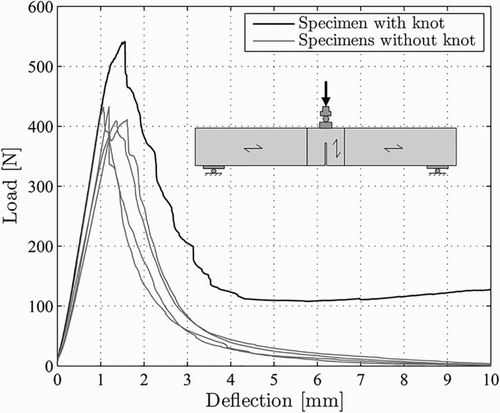
Other test methods like compact tension (CT) tests, double cantilever beam tests, or wedge loaded splitting tests have been applied in micromechanical studies on the fracture behaviour of wood (Petterson and Bodig Citation1983; Pizio Citation1991; Jensen Citation2005).
A detailed study of test series with specimens of different wood species, densities, and geometrical parameters subjected to SENB experiments is reported in (Larsen and Gustafsson Citation1990) where the authors state that the tested volume should be free of knots in order to achieve safe results due to the considerable increase of fracture energy in case of the presence of knots.
The load deformation behaviour of a SENB specimen with the presence of a knot in the crack path is reported in Riberholt, Enquist, Gustafsson and Jensen (Citation1991). The authors conclude that knots in the crack path act like a reinforcement: after the ultimate load has been reached, the specimen exhibits a remarkable residual resistance, which can be observed e.g. in the force displacement diagram in .
An investigation on the spatial distribution of fracture energy Gf,I along the length of Norway spruce (picea abies) lamellas is reported in (Jockwer Citation2014). In specimens with knots directly in the crack path, very high fracture energy values were reached () and also for specimens cut from beam portions near the knot (position 1) increased fracture energy values were observed (). Within the clear wood section of the lamella, the fracture energy depended only on the growth ring angle, but no indication of dependency on further parameters could be observed: in , the central lamella with fracture plane mostly tangential to the growth rings shows a tendency to low fracture energy, whereas the side specimens with a fracture plane crossing different growth rings show a tendency to higher fracture energy values.
2 Spatial distribution of fracture energy within a lamella derived from 27 tests (Jockwer Citation2014). The right specimen at position 1 contains a knot in the crack plane
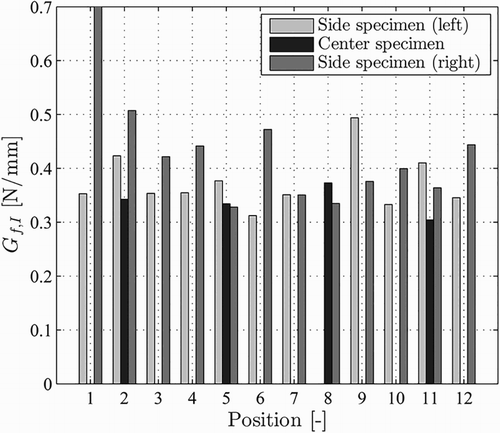
A problem occurring when subjecting specimens with knots to SENB and other small-scale tests is that the crack bridging effect of the knot results in comparably high remaining resistance of the specimen after crack initiation and also for large deflections of the specimens.
The presence or absence of knots in or near the crack path has a considerable influence on the fracture energy when determined on small-sized specimens. Excluding specimens with knots from the samples when determining the fracture energy on small-sized specimens may lead to a conservative estimate of the fracture energy of timber members of structural size. The influence of knots may be accounted for by performing tests on full-scale specimens of structural size when intending to determine fracture energy values to be used in the design of timber structures.
Impact of knots on the fracture energy of specimens of structural size
Situations in structures where timber members are exposed to the risk of fracture due to excessive tensile stresses perpendicular to the grain or shear stresses should, in general, be avoided. Examples of structural details prone to cracking are notched beam supports, holes in beams, connections loaded perpendicular to the grain or connections with reduced end distances and/or spacing.
While knots in SENB reinforce the crack mainly in tension perpendicular to the grain (mode 1), the knots in end-notched beams with mixed mode fracture reinforce the crack by crack-bridging (mode 1) and dowelling (mode 2).
Larsen and Riberholt (Citation1972) report experiments to assess the difference in the structural behaviour of graded and ungraded solid timber beams with notches. The fracture behaviour and load-carrying capacity of beams with different depths of the notched part of the beam, αh (), were determined in 3-point bending. In , the average shear stress at failure Vult/(bαh) is shown for different relative notch depths α. It is obvious that load-carrying capacities of beams with knots are considerably higher at the mean level.
3 Geometrical parameters of an end-notched glulam beam with an illustration of the measurement of the crack opening δ in the notch corner
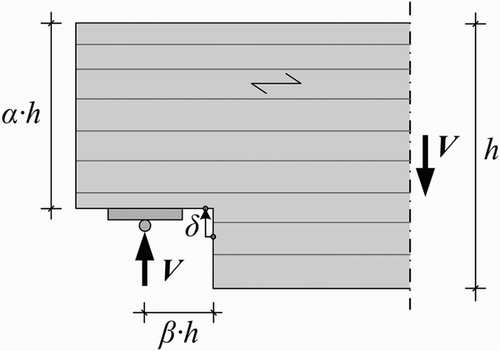
4 Cumulative distribution of the average shear stress at failure Vult/(bαh) from end-notched beam tests on an initially ungraded sample of solid timber reported in Larsen and Riberholt (Citation1972)
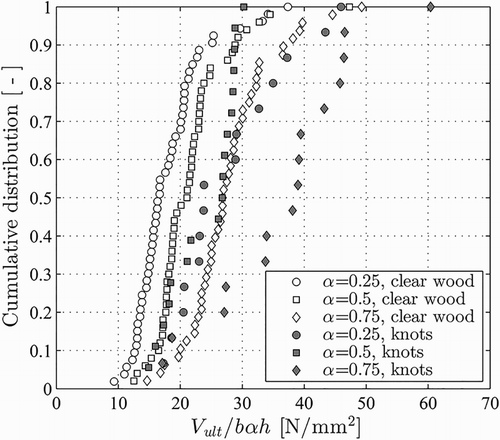
Möhler and Mistler (Citation1978) performed tests on end-notched beams with different notch depths. The solid timber subjected to experiments was graded into samples with clear wood, with knots and with checks and red rot in the region of the notch corner. The average shear stress at failure Vult/(bαh) is depicted in . The mean values of the specimens with knots are higher than those of the specimens with clear wood. In case of the presence of checks or red rot, most often the determined load-carrying capacities were lower.
5 Mean values and standard deviations of the average shear stress at failure Vult/(bαh) from end-notched beam tests on solid timber beams reported in Möhler and Mistler (Citation1978)
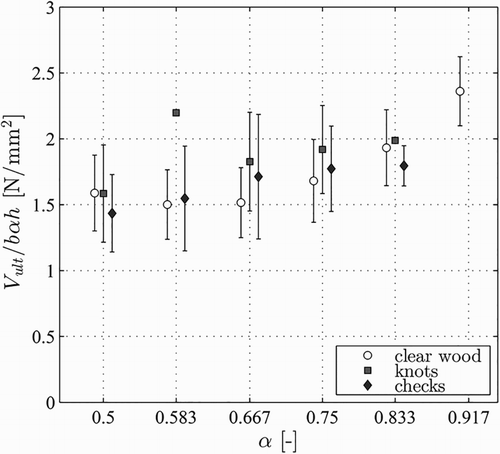
In a test series on solid timber and glulam beams, Riberholt et al. (Citation1991) studied the influence of different geometrical parameters of the notch. The authors defined the load-carrying capacity of the notched beam as the load at unstable crack growth. In some cases, blocking of crack growth by knots along the crack path was observed allowing to further increase the load until unstable crack growth was observed or until bending failure occurred. The ultimate load-carrying capacity (after unstable crack growth) was around 34% higher in beams with knots along the crack path than the load at unstable crack growth in beams without knots. These higher load-carrying capacities are indicators for the reinforcing effect of the knots and emphasise the impact of growth characteristics on fracture energy. In other cases, crack initiation before unstable crack growth was observed. The crack stopped at a certain distance from the notch corner before unstable crack growth occurred at higher loads. Cracks initiated, on average, at levels of approximately 84% of the load at unstable crack growth.
Jockwer (Citation2014) studied the load-carrying capacity of end-notched beams and suggested optimised reinforcement methods. In a test series on unreinforced glulam beams, the crack opening and crack shearing displacements were measured in the notch corner. In addition, the surface deformations were recorded and analysed by means of digital image correlation (DIC). In the tests with immediate failure after crack initiation in most cases, no knots or grain deviations could be observed along the crack path (a). In contrast, knots or grain deviations seemed to be the reason for a marked deceleration of crack growth (b). The average shear stresses (V/(bαh)) in dependency of the deflection at load introduction point are shown in for a specimen with a knot in the crack path and a specimen with clear wood along the crack path (). In , the average shear stresses for the same specimens are graphed versus the crack opening deformation at the notched corner. Beams with knots in the vicinity of the notched corner exhibited higher load-carrying capacities. After crack initiation, crack opening was limited and the load could be increased further. Beams with clear wood near the notch failed in a brittle way with unstable crack growth at failure loads similar to crack initiation loads observed when testing beams with knots near the notched corner. The knots obviously had a reinforcing effect and led to deceleration or even a stop of crack growth.
6 Crack path with a clear wood and b a knot in the vicinity of the notch corner from tests on notched glulam beams (Jockwer Citation2014)
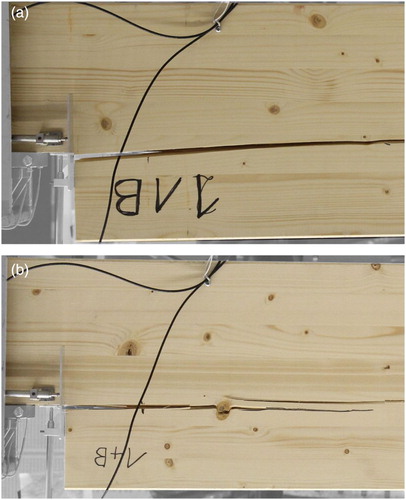
7 Average shear stresses (V/(bαh)) in dependency of the deflection at the load introduction point. Comparison between a specimen with a knot along the crack path and a specimen with clear wood along the entire crack path (Jockwer Citation2014)
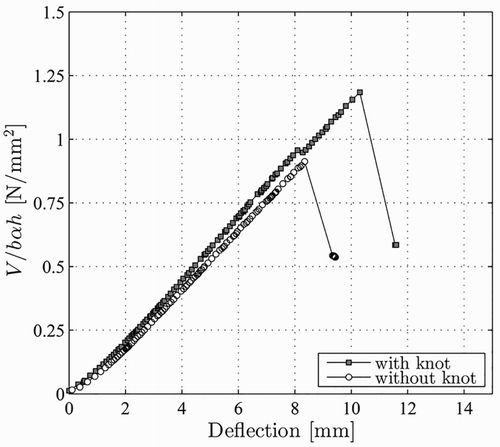
8 Crack opening δ at the notch corner of notched beam specimens with and without knots along the crack path (Jockwer Citation2014)

In addition to these studies, Jockwer (Citation2014) evaluated the strain state at the notched corner and at the crack tip by means of DIC measurements. Before crack initiation, the tension perpendicular to grain and shear strain showed the typical singularity at the notch corner. In case of clear wood in the vicinity of the notch corner, unstable crack growth developed from this singularity of strains and stresses. If knots along the crack path were present, a redistribution of crack driving forces was possible. In some tests, a considerable decrease in tension perpendicular to grain strains was observed when the crack tip reached a knot.
Modelling of the impact of knots in the crack path on fracture energy
When modelling the structural behaviour of timber members by means of the finite element method, the variability in material properties should be accounted for (e.g. Smith, Snow, Asiz and Vasic Citation2007). Variation in material properties of timber can be reduced by strength grading the raw material as it is commonly done for e.g. solid timber and lamellae used in glulam production. However, for members subjected to mainly tension perpendicular to grain or shear, no adequate strength grading criteria exist.
Jockwer (Citation2014) evaluated results from tests on end-notched glulam beams and analysed the variation in load-carrying capacities determined in the tests. The variation in material properties was implemented in an analytical end-notched beam model proposed by Gustafsson (Citation1988) which is based on the energy balance during infinitesimal increase of the crack length at the notch corner. Material properties were assumed lognormal distributed as suggested by JCSS (Citation2001). It could be shown that the variation in the elastic material properties of the timber and the variation of mode 1 fracture energy (opening mode) in the clear wood are not sufficient to explain the variation in load-carrying capacities observed in the tests. The higher variation of the test results can, however, be accounted for by including a model uncertainty with a coefficient of variation CoV = 23% in the analytical model. The reason for this variation of the model uncertainty was then studied more in detail by means of a Finite Element model with Monte Carlo varied material properties. As illustrated in , predefined crack starting at the notch corner was separated into sections representing clear wood and into knot sections as described in Fink (Citation2014). In the clear wood sections, the critical energy release was lognormal distributed with Gc,I ,mean = 0.3 N mm−1 and CoV = 20%, in agreement with the test results on small clear SENB specimens as discussed above. In the knot sections, the critical energy release rate was increased by an additional, lognormal distributed knot factor in order to account for the increase of fracture energy caused by the knot. The distribution parameters of the knot factor can be determined by fitting the results of the simulation to test results from the literature. Fitting the results of the simulation to test results from the literature yields to a knot factor with a mean value of approximately 2 and a coefficient of variation of 40%.
9 Example of the FE-Model of an end-notched glulam beam during progressive crack growth with a realisation of the randomly distributed clear wood and knot sections (Jockwer Citation2014). The light grey dots along the crack path represent nodes assigned to clear wood material properties, whereas the black dots represent nodes assigned to higher fracture energy values of knot sections

In , examples of load–deflection curves from calculations with FE-Models of end-notched glulam beams with knots along the crack path are shown. It was observed that only the knot sections close to the notched corner influenced the load-carrying capacity of the notched beams due to the rapid increase of energy release rate with progressing crack length. Specimens with knots along the crack path are responsible mostly for high load-carrying capacities.
10 Examples of load deflection curves from FE-Models of end-notched glulam beams with knots along the crack path (Jockwer Citation2014)

A conceptual approach that can take into account the reinforcing effect of knots and grain deviation for situations where crack propagation is governing the failure has been presented in Gustafsson, Jockwer, Serrano and Steiger (Citation2015) and Jockwer, Serrano, Gustafsson and Steiger (Citation2015). In this strongest link model, the failure of e.g. a notched beam is assumed to occur when the crack propagates beyond the section along the crack path that shows the largest resistance to crack propagation (within reasonable limits in terms of distance from the notch corner). The strongest link model predicts for such situations an increased load-carrying capacity with increased size, i.e. an inversed size effect as compared to the traditional Weibull weakest link model.
Conclusions
Knots are commonly seen as weak spots decreasing the strength of structural timber members when subjected to bending stresses or tensile stresses parallel to grain. On the other hand, knots can cause a considerable increase in fracture energy due to a crack bridging and dowelling effect during crack growth when specimens are subjected to tensile stresses perpendicular to the grain or to shear along the grain. Also in tests on end-notched beams, an increase in load-carrying capacity can be observed if the specimens contain knots along the crack path. This can be confirmed by performing numerical FE calculations setting up models with varying critical energy release rates along the crack path. From the experiments as well as from the numerical studies, it can be concluded that this positive impact of knots should be accounted for when intending to correctly model or evaluate tests with timber members of structural size. Starting from the well-known weakest link model by Weibull, a strongest link model recently developed and published shows the potential of being an efficient tool in modelling the positive impact of knots and local grain deviations on the strength of wood when subjected to shear stresses and stresses perpendicular to the grain.
Acknowledgement
The presented study was performed during a Short Term Scientific Mission (STSM) at Lund University, Sweden. The support of COST Action FP 1101 for this STSM is gratefully acknowledged.
ORCID
R. Jockwer http://orcid.org/0000-0003-0767-684X
E. Serrano http://orcid.org/0000-0002-5333-0682
R. Steiger http://orcid.org/0000-0002-0096-098X
Notes
1 i.e the fracture energy as evaluated from the test results assuming there are neither knots nor grain deviations.
References
- CEN. 2004. EN 1995-1-1: Eurocode 5: Design of Timber Structures – Part 1–1: General – Common Rules and Rules for Buildings. Bruxelles, Belgium: European Committee for Standardization CEN.
- Fink, G. 2014. Influence of varying material properties on the load-bearing capacity of glued laminated timber, Diss. ETH NO. 21746. PhD thesis, Inst. of Struct. Eng., ETH Zurich, Switzerland.
- Frühwald Hansson, E. 2011. Analysis of structural failures in timber structures: typical causes for failure and failure modes. Engineering Structures 33(11), 2978–2982. doi: 10.1016/j.engstruct.2011.02.045
- Gustafsson, P. J. 1988. A study of strength of notched beams, Proceedings of the CIB-W18 Meeting 21, Parksville, Canada, Paper No. CIB-W18/21-10-1.
- Gustafsson, P.-J., Jockwer, R., Serrano, R. and Steiger, R. 2015. A strongest link model applied to fracture propagating along grain, INTER/48-19-2, Proceedings of the 2nd INTER Meeting: International Network on Timber Engineering Research, Šibenik, Croatia, 24–27 August 2015, page 351–366.
- JCSS. 2001. Probabilistic Model Code. Joint Committee of Structural Safety, available online at: http://www.jcss.byg.dtu.dk/
- Jensen, J. L. 2005. Quasi-non-linear fracture mechanics analysis of the double cantilever beam specimen. Journal of Wood Science 51(6): 566–571. doi: 10.1007/s10086-005-0700-4
- Jockwer, R. 2014. Structural behaviour of glued laminated timber beams with unreinforced and reinforced notches, Diss. ETH NO. 21825. PhD thesis, Inst. of Struct. Eng., ETH Zurich, Switzerland.
- Jockwer, R., Serrano, R., Gustafsson, P.-J. and Steiger, R. 2015. Impact of growth characteristics on the fracture perpendicular to the grain of timber, Proceedings of the 12th International Conference on Applications of Statistics and Probability in Civil Engineering (ICASP12), Editor: Haukaas, T., Vancouver, British Columbia, Canada, 13–15 July 2015, page 2429.
- Larsen, H. and Gustafsson, P. J. 1990. The fracture energy of wood in tension perpendicular to the grain, Proceedings of the CIB-W18 Meeting 23, Lisbon, Portugal, Paper No. CIB-W18/23–19–2.
- Larsen, H. J. and Riberholt, H. 1972. Forsøg med uklassificeret konstruktionstræ. Vol. R 31, Afd. for Bærende Konstruktioner, Danmarks Tekniske Højskole.
- Möhler, K. and Mistler, H. L. 1978. Untersuchungen über den Einfluss von Ausklinkungen im Auflagerbereich von Holzbiegeträgern auf die Tragfestigkeit, Vol. F 1504. Fraunhofer IRB Verlag, Stuttgart, Germany.
- Nordtest. 1993. Wood: Fracture energy in tension perpendicular to the grain, Vol. NT Build 422. Nordtest, Espoo, Finland.
- Petterson, R. W. and Bodig, J. 1983. Prediction of fracture-toughness of conifers. Wood and Fiber Science 15(4): 302–316.
- Pizio, S. 1991. Die Anwendung der Bruchmechanik zur Bemessung von Holzbauteilen, untersucht am durchbrochenen und am ausgeklinkten Träger. Vol. 91–1, Institut für Baustatik und Stahlbau der ETH Zürich, Zurich, Switzerland.
- Riberholt, H., Enquist, B., Gustafsson, P. J. and Jensen, R. B. 1991. Timber beams notched at the support. Vol. R 280, Afd. for Bærende Konstruktioner, Danmarks Tekniske Højskole, Denmark.
- Smith, I., Snow, M., Asiz, A. and Vasic, S. 2007. Failure mechanisms in wood-based materials: a review of discrete, continuum, and hybrid finite-element representations. Holzforschung 61(4), 352–359. doi: 10.1515/HF.2007.055
